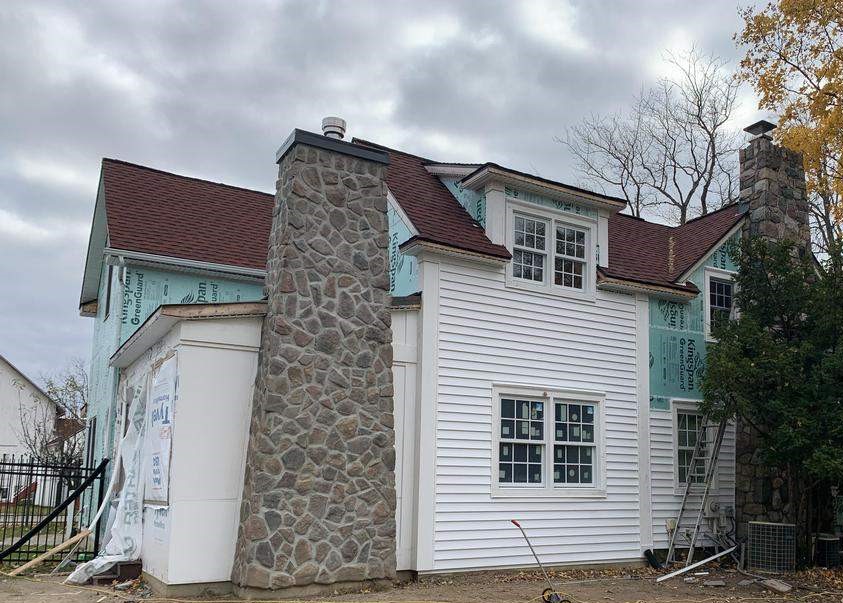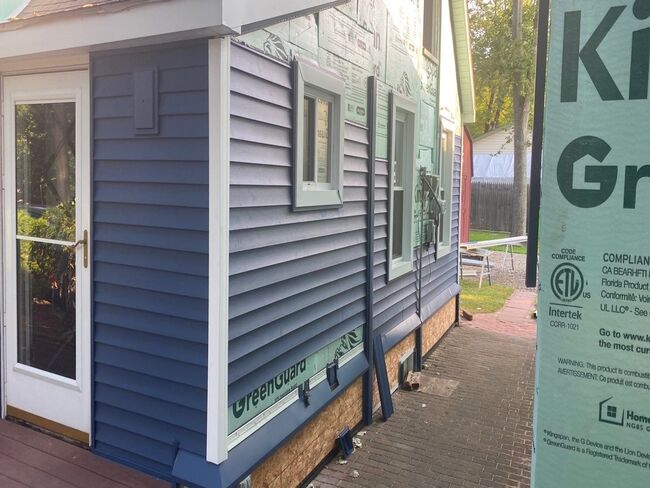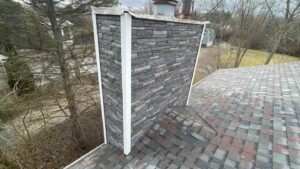
Siding Cost Factors For Your Michigan Home
Installing new siding is a great way to improve the look of your home and give it a more pleasant appeal. If you’re considering new siding for your home in Michigan, one of your top concerns is likely the cost of siding installation. There are several factors that determine the cost of a full siding installation project, and we are here to break them down for you.
Your Michigan Home’s Shape
The shape of the home you’re installing siding on is going to affect the price of siding installation as well. If there are a lot of bends and decorative features in the design of your home’s exterior, there will be more cuts and other forms of customization that will occur during installation. These extra steps add time and money to the process, so be sure to consider this as well.
The Size of Your Home
The size of your home is going to be one of the biggest factors in determining the cost of siding installation. Siding is dealt with in terms of squares, where one square of siding is equal to about 100 square feet. In most cases, siding costs about $600 per square. If you have a smaller space of around 400 square feet, it’ll cost about $2,400. The average home in Michigan will need approximately 15 squares, costing the homeowner around $9,000.

Vinyl siding replacement project in Whitmore, Michigan
The Type of Siding Matters Most
Just like most things in life, you have options when you decide to install siding. Depending on the material you choose, your overall cost may be above or below the average in Michigan. At 180 Contractors, we recommend vinyl siding as a durable, low maintenance, and cost-effective option. With vinyl siding, we are able to create a custom style to give your home the look you desire. Vinyl siding will also save you money in the long run, as it requires minimal maintenance and is engineered to withstand all of Mother Nature’s unexpected events. The varied vinyl siding costs are broken down below.
Vinyl Shake Siding:
Emulating the charm of wood or cedar shakes, vinyl shake siding offers rows and hand-split styles. Cedar rows consist of embossed wood grain shingles, measuring 5 or 7 inches wide and stacked two or three high. Hand-split shakes are irregularly shaped shingles, providing a rustic aesthetic. Prices for both styles range from $3 to $10 per square foot, depending on the grade, with potential additional labor costs due to their unique installation requirements.
Traditional Lap Siding:
If you prefer a classic and straightforward look, traditional lap siding is a horizontal option with a woodlike texture. It offers affordability, averaging around $4 per square foot.
Clapboard:
Clapboard siding replicates basic plank siding but with wider bottom planks, tapering towards the top in a wedge shape. This design enhances depth and shadow, lending a richer appearance to your home. Clapboard vinyl siding comes in various colors and embossing patterns, priced between $2 and $6 per square foot, depending on grade and insulation.
Insulated Vinyl Siding:
Insulated vinyl siding provides a solid structure by integrating insulation directly into the vinyl. This feature simplifies installation and adds weight to the siding. Most styles can be obtained with attached insulation, with prices ranging from $4 to $12 per square foot based on the chosen style.
Vertical Vinyl Siding:
Vertical vinyl siding, running from top to bottom, can be used to accentuate architectural features or create a specific period-inspired look. On average, vertical vinyl siding costs $5.50 per square foot.
Vinyl Log Siding:
Vinyl log siding offers the rustic charm of log-built homes without the cost and upkeep. With 12-inch rounded, wood-grain-textured panels running lengthwise, this hollow-style vinyl siding mimics the appearance of logs. It can be installed on any home, adding a touch of rustic appeal at a cost between $3 and $5 per square foot.
Dutch Lap Siding:
Dutch lap siding is a horizontally installed style popular for its overlapping planks, adding visual interest to a simple design. It is available in hollow or insulated options, with an average price range of $3 to $9 per square foot.
Brick-like Vinyl Siding:
With a resemblance to brick, brick-look vinyl siding serves as an accent alongside horizontal styles, offering a cost between $5 and $10 per square foot.
Stone-like Vinyl Siding:
Stone-look vinyl siding, often used as an accent material, presents a more natural appearance with variations in color and texture. The price range for stone-look siding falls between $5 and $10 per square foot.

Board-and-Batten Vinyl Siding:
Originating from early American exterior siding, board-and-batten siding is made from vertically attached wood panels with thin strips called battens covering the gaps. Vinyl board-and-batten siding eliminates the risk of battens detaching and ensures a leak-free exterior. The average cost for this style ranges from $4 to $9 per square foot.
Beaded Vinyl Siding:
Featuring horizontal boards with a decorative lip for added depth, beaded vinyl siding offers a slightly more ornamental choice. Typically priced between $3 and $7 per square foot.
Smooth Vinyl Siding:
Smooth vinyl siding, lacking the woodlike texture of other horizontal planks, provides a modern, dirt-resistant look. Expect to pay around $4 per square foot for this option.
Scalloped Vinyl Siding:
Scalloped vinyl siding offers an accent style that can be paired with horizontal siding, giving your home a decorative or historic feel. Prices typically range from $4 to $9 per square foot.
Fiber Cement Cost
Advantages of Vinyl Siding
Traditional materials like wood, brick, and stucco have long been used for home protection, but newer options such as fiber cement, aluminum, composite, and vinyl have gained popularity. Each material has its own style, maintenance requirements, and cost considerations. Among these choices, vinyl siding often emerges as the preferred option.
Long-lasting
Vinyl siding is resistant to insects, hail damage, and fading from sunlight. Its color is integrated into the material, preventing scratches and scuffs. With proper climate conditions, quality installation, and maintenance, vinyl siding can endure for decades. Unlike other siding types, it doesn’t deteriorate with age, ensuring a lasting investment.
Versatility
Vinyl siding offers a wide range of trim and accessory options, which were traditionally made from wood. This eliminates concerns about painting, swelling, cracking, warping, or insect-related issues associated with wood. Additionally, new vinyl products replicate the appearance of various wood, brick, and stone styles, allowing homeowners to mix and match materials without the usual maintenance challenges.
Easy Installation
Vinyl siding is lightweight and comes in sections that can be easily nailed into place, making installation a hassle-free process. Compared to wood or brick siding, vinyl is more cost-effective when it comes to professional installation.
Low Maintenance
Unlike other exterior cladding materials, vinyl siding doesn’t require painting or caulking. It can be easily cleaned with mild soap and water using a garden hose. In rare cases of impact or severe weather, vinyl siding may need to be reset. In contrast, wood and brick siding can suffer from extensive insect and weather damage, leading to expensive repair and restoration costs. With vinyl siding, there’s no need for regular scraping, painting, repainting, recoating, or insect treatments.
Energy Efficiency
Vinyl siding creates an airtight seal, preventing heat and cool air from escaping the home. Insulated vinyl siding offers even greater energy efficiency compared to hollow siding. This helps homeowners save on energy bills and is environmentally friendly.
Color Retention
Vinyl siding retains its color as the pigment is embedded into the material during production. Homeowners don’t need to touch up paint or perform maintenance to keep the color intact. However, if desired, vinyl siding can be painted if the homeowner wishes to change the color, even before the siding starts to wear out or if they purchase a home with siding they dislike.
How to save money and worry less on vinyl siding cost and installation
- For homeowners who are crunching the numbers on a vinyl siding cost calculator, it’s no surprise that expenses can quickly pile up. However, there are clever ways to save money without compromising on quality.
- Consider a lower-grade material. Instead of splurging on premium or thicker options, explore standard or economy grade alternatives.
- Explore diverse texturing choices. Manufacturers offer a plethora of options with varying price tags. Opting for flat or lightly textured siding tends to be more budget-friendly compared to deeply textured alternatives.
- Tap into potential tax breaks. If you opt for insulated siding or rigid board insulation, consult local and state agencies to discover any tax incentives related to improved energy efficiency.
- D.I.Y. old siding removal. By taking on the task of removing the old siding yourself, you can save a few bucks on labor costs. However, make sure you’re comfortable with the process and research thoroughly before diving in.
- Get multiple quotes. Obtain estimates from several contractors to compare prices and find the most competitive offer available in your area.
- Shop around for different siding brands. Some contractors exclusively work with specific companies, but you might find a better deal by exploring alternative manufacturers.
- Time it right. Schedule the siding job during the off-season to potentially secure lower costs. Off-season pricing varies by region, so plan accordingly when the crew is in less demand.
Let’s Discuss Your Siding Today
When you want to dramatically improve the look of your home, new siding is a great way to do so. Contact 180 Contractors today to discuss siding options for your Michigan home.
